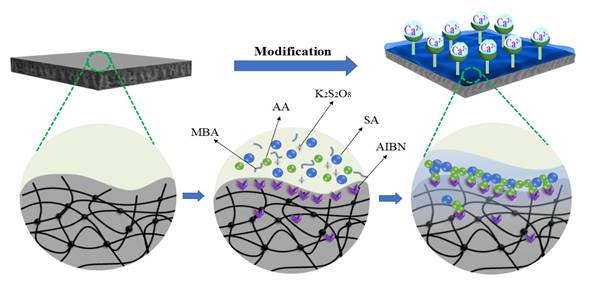A research group led by Prof. LIU Fu at the Ningbo Institute of Materials Technology and Engineering (NIMTE) of the Chinese Academy of Sciences (CAS), developed anticoagulant dialyzers via a hydrogel skin implantation strategy, which has achieved heparin free hemodialysis for patients with end-stage renal disease (ESRD). The study was published in Journal of Membrane Science.
The increasing number of patients with ESRD calls for high-performance and cost-effective dialyzers. Currently, the majority of commercial hemodialysis membranes are fabricated by polymeric materials with limited hemocompatibility. These materials can easily trigger coagulation cascade and thus evoke thrombosis, which would meditate the immune recognition and lead to a series of polymer-specific antibody response in vivo.
In addition, heparin sodium (HS) employed in clinical hemodialysis for preventing thrombosis can provoke risk of bleeding and side effects, like thrombocytopenia and osteoporosis.
To address this issue, the researchers at NIMTE have conducted a series of research on anticoagulant dialysis membranes since 2014, and yielded creative achievements. Recently, they proposed an environmentally friendly hydrogel skin strategy to modify polysulfone (PSf) membranes and commercial dialyzers for enhanced hemocompatibility with heparin free administration. Poly (sodium alginate-acrylic acid) P (SA-AA) network was polymerized in aqueous solution and firmly implanted onto the PSf membrane via the pre-seeding of initiator. The modified membrane bearing abundant carboxylate groups contributed to excellent hydrophilicity and Ca2+ chelation capability, thus inhibited the blood coagulation cascade significantly.
Moreover, the developed dialyzer showed excellent anticoagulant performance, minimized the immune response of human body, and even improved toxins clearance during the dialysis session.
The study shed some light on the design and modification of self-anticoagulant dialyzers, and promised anticoagulant dialyzers for heparin free dialysis a bright future for clinical application.
This work was financially supported by The National Natural Science Foundation of China (No. 51973230), Zhejiang Provincial Natural Science Foundation of China for Distinguished Young Scholars (No. LR20E030002), Youth Innovation Promotion Association of Chinese Academy of Science (No. Y201848), Ningbo Science and Technology Bureau (No. 2017C110034, 2014B81004).

Fig. Preparation of the self-anticoagulant dialyzer via hydrogel skin implantation
Contact
LIU Fu
Ningbo Institute of Materials Technology and Engineering
E-mail: fu.liu@nimte.ac.cn

